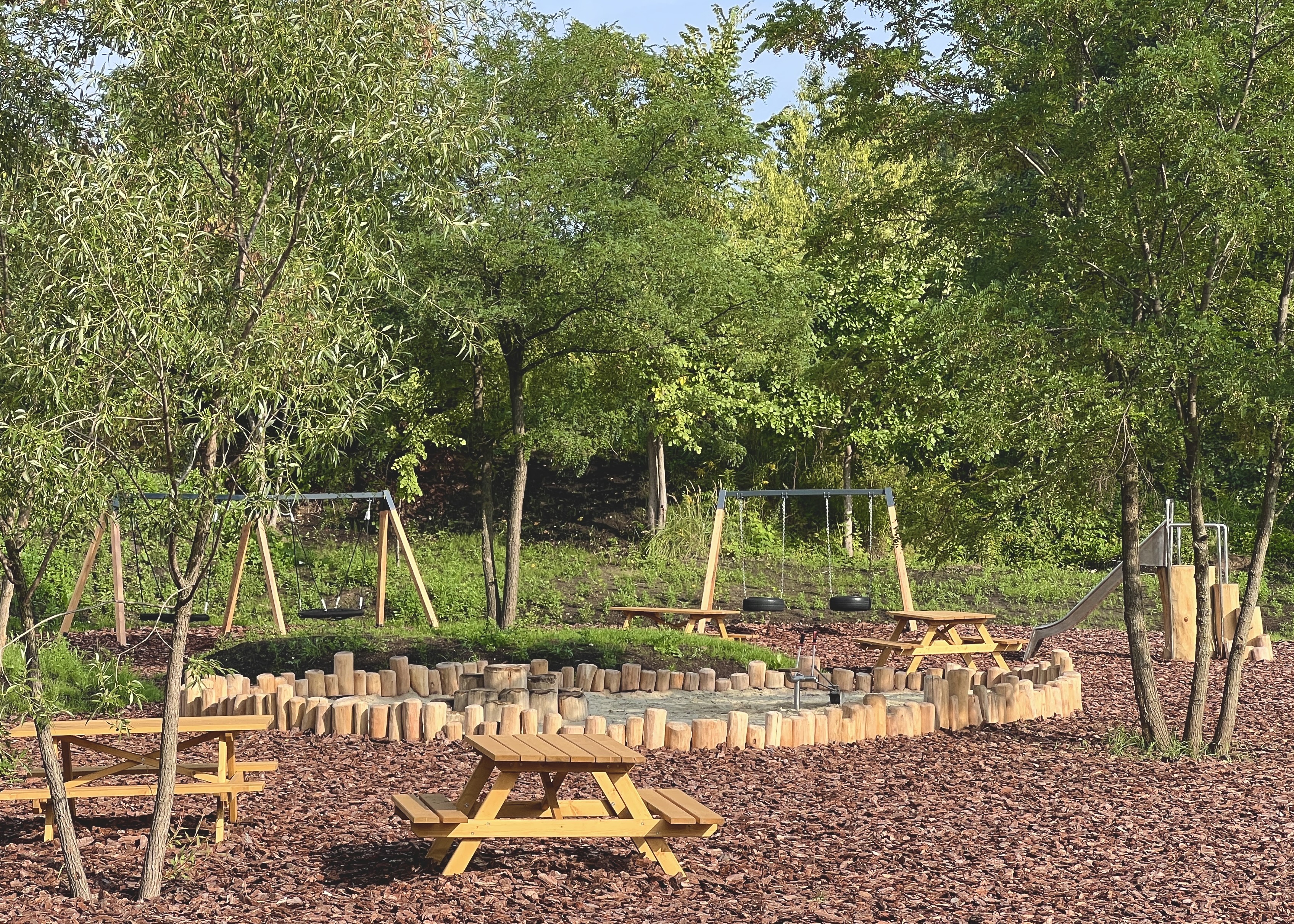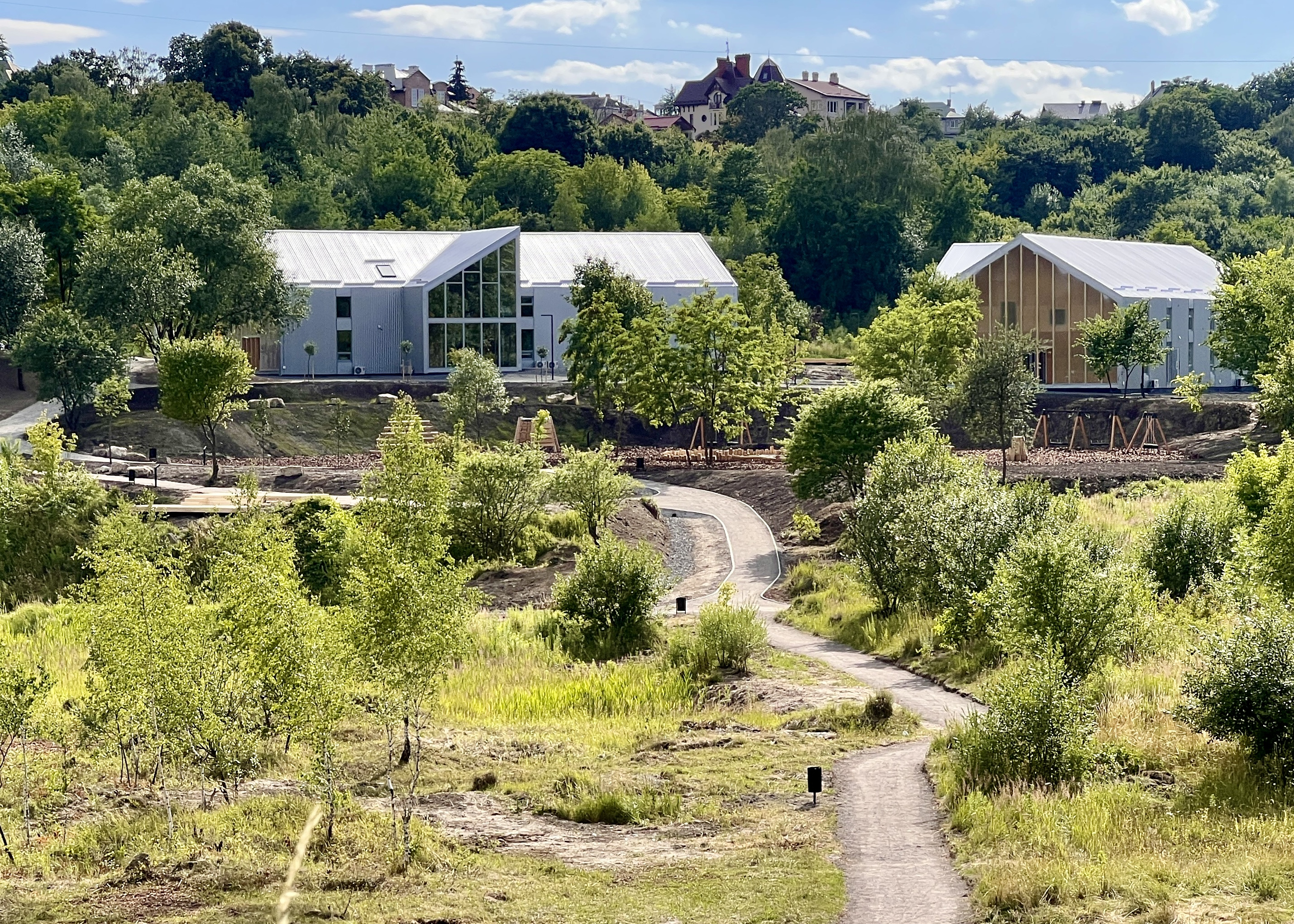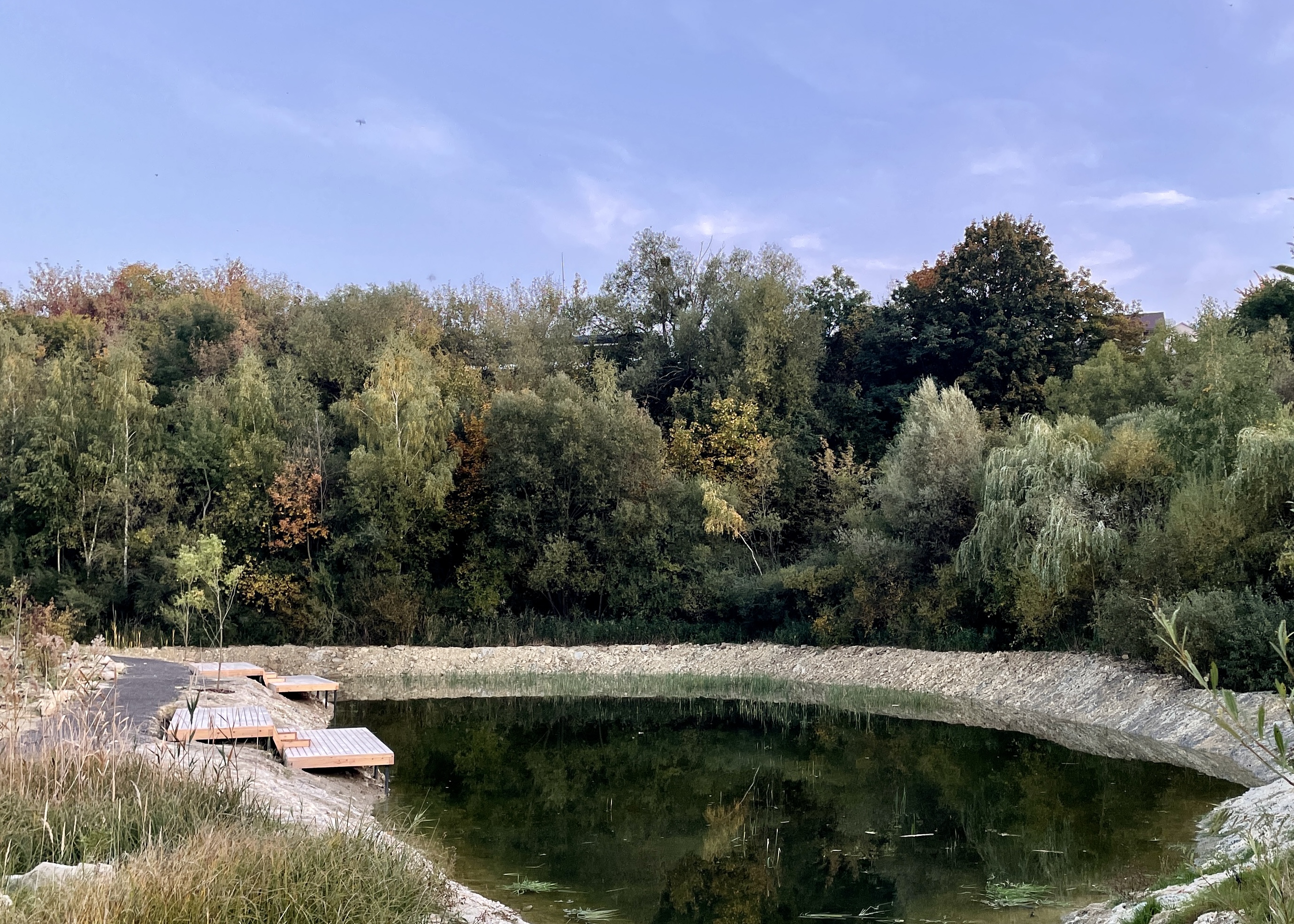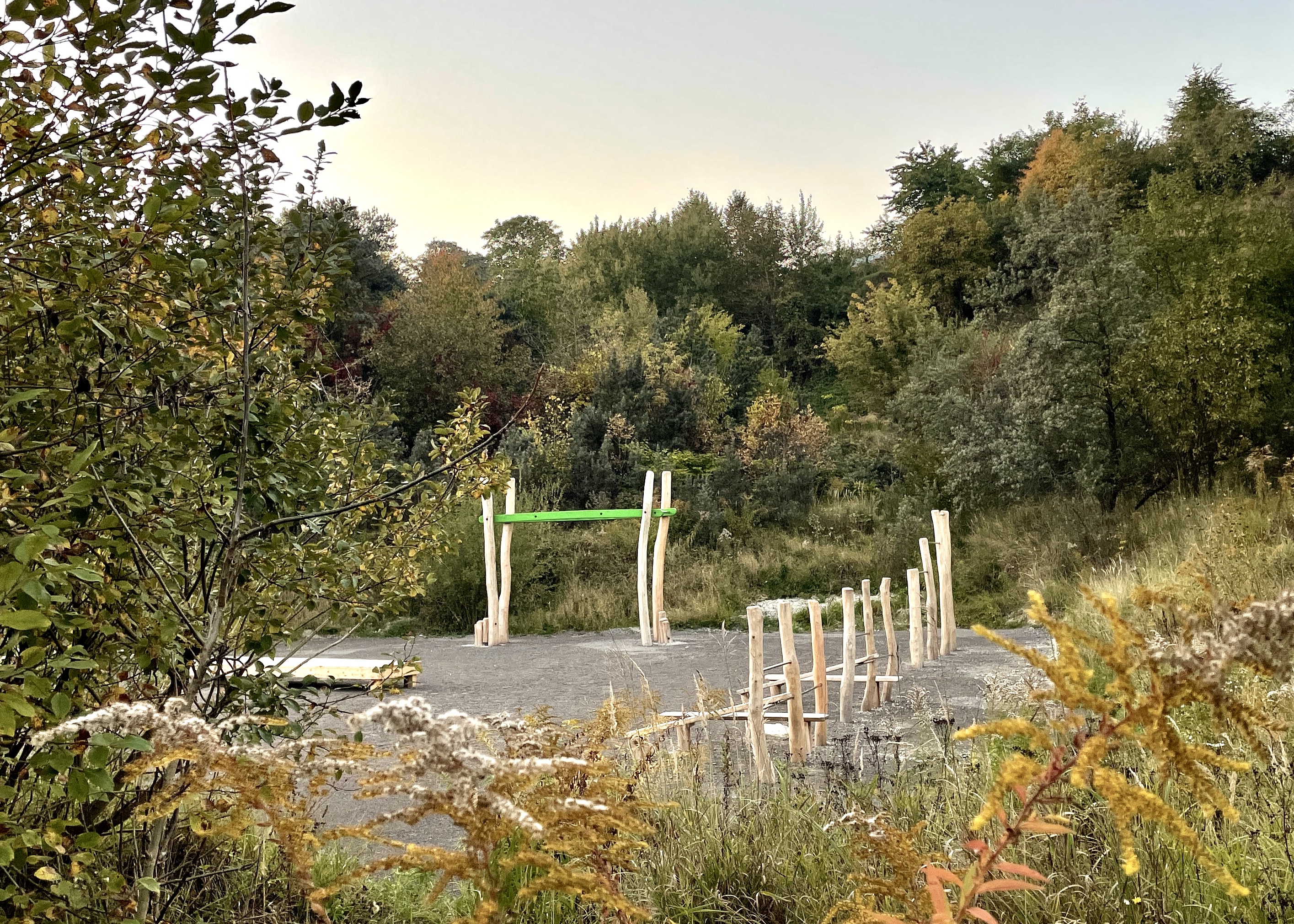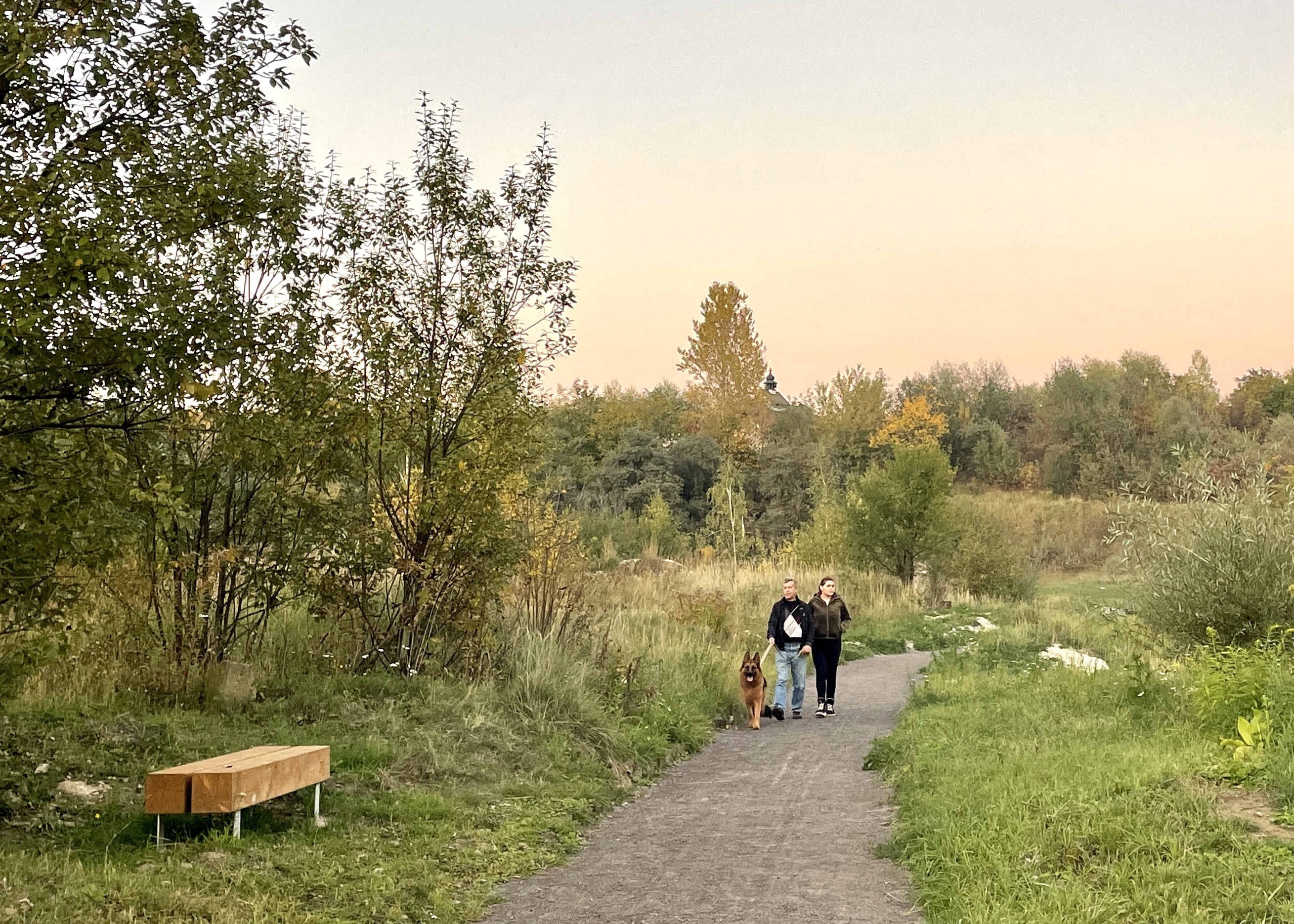Reconnecting with nature
Nad Dzherelom
Nad Dzherelom: recreation area of Unbroken Mothers
The recreation area "Nad Dzherelom" (Over the source) is part of the Unbroken Mothers complex, which in turn is an element of the Unbroken ecosystem. Unbroken is a response of the city to the challenges of war. "Nad Dzherelom" project aimed to restore an abandoned natural area for social integration of internally displaced persons with the local community while preserving the ecosystem and biodiversity.
EU Member State, Western Balkans or Ukraine
Ukraine
Local
Lviv
No
No
Mainly urban
It refers to a physical transformation of the built environment (hard investment)
Yes
2022-07-15
No
No
Yes
Yes
Yes
As a representative of an organisation, in partnership with other organisations
The project aimed to create a sustainable, inclusive, beautiful space that will bring people and communities closer to nature, contributing to the restoration of natural ecosystems and preventing the loss of biodiversity by inviting them to reconsider their relationship with nature from the perspective of life as an alternative to anthropocentrism.
The transformation of place shows how renewed or regenerated built environments and public spaces can contribute to the protection, restoration or regeneration of natural ecosystems and biodiversity. The use of nature-oriented solutions and materials can be an important aspect of the transformation of space.
The transformation should promote social integration for example taking into account the accessibility of the place including the principles of design for all using the preservation and restoration of the environment as a common task for the whole community using green areas as connecting links between the common and shared spaces of different districts.
The goal of the project:
to create a recreational area for the integration of internally displaced persons into the community and provide a comfortable environment for psychological recovery by revitalizing natural areas.
Objectives:
to create a public space for the integration of Internally displaced persons with the local community
to create a green space aimed at the mental recovery and rest of city residents.
the regeneration of the natural territory involves the restoration of the natural ecosystem, the preservation of biodiversity and the creation of a sustainable ecological environment.
Target group:
Pregnant women and women with children who are internally displaced persons due to a full-scale invasion of Russia on the territory of Ukraine.
Communities of the city of Lviv - persons who live in the city of Lviv and are interested parties who can take advantage of the benefits and services that the recreation zone provides.
The transformation of place shows how renewed or regenerated built environments and public spaces can contribute to the protection, restoration or regeneration of natural ecosystems and biodiversity. The use of nature-oriented solutions and materials can be an important aspect of the transformation of space.
The transformation should promote social integration for example taking into account the accessibility of the place including the principles of design for all using the preservation and restoration of the environment as a common task for the whole community using green areas as connecting links between the common and shared spaces of different districts.
The goal of the project:
to create a recreational area for the integration of internally displaced persons into the community and provide a comfortable environment for psychological recovery by revitalizing natural areas.
Objectives:
to create a public space for the integration of Internally displaced persons with the local community
to create a green space aimed at the mental recovery and rest of city residents.
the regeneration of the natural territory involves the restoration of the natural ecosystem, the preservation of biodiversity and the creation of a sustainable ecological environment.
Target group:
Pregnant women and women with children who are internally displaced persons due to a full-scale invasion of Russia on the territory of Ukraine.
Communities of the city of Lviv - persons who live in the city of Lviv and are interested parties who can take advantage of the benefits and services that the recreation zone provides.
nature-based solutions
inclusion
biodiversity
internally displaced persons
nature-based rehabilitation
The place where the landscape zone was created is the territory of the former quarry (so-called Piskovnya) which after its closure stood empty and turned into forgotten impassable thickets and a natural garbage dump. Therefore, the goal of our project was to update this area and make it convenient and aesthetic for the use of communities to restore the connection with nature.
The project strategy distanced itself from the usual standards of natural environment development trying to restore the barely healed quarry landscape to open it to the general public. In the project only point addition of greenery was foreseen. The landscaping is not maintained by humans, the system is self-regulating. Planning decisions and construction work were organized in such a way as to minimize interference with the established ecosystem. The relief of the territory was not changed. Playgrounds and sports grounds are placed on existing flat areas so as not to interfere with the existing topography and to integrate recreation areas into the vegetation. These were also the most littered areas (natural garbage dumps).
All landscaping elements (children's and sports grounds, terraces, benches, etc.) were made of natural materials such as wood and steel. Paths made of crushed stone and without edging. First, such a solution minimizes the resources for the arrangement. Second, it blurs the line between "wild" and "tamed" and depending on the intensity of human use of the paths, nature can absorb part of the cover. Thirdly, such an overlap is water-permeable, so all rainwater can pass into the ground. Fourthly, this technology allows you to quickly implement the project. Large stones/boulders found in the area are reused as decorative boulders.
After the implementation of the project, we can see how an unattractive area in the tension zone between city highways and thickets was able to become an aesthetic place for the rehabilitation and recreation of the community.
The project strategy distanced itself from the usual standards of natural environment development trying to restore the barely healed quarry landscape to open it to the general public. In the project only point addition of greenery was foreseen. The landscaping is not maintained by humans, the system is self-regulating. Planning decisions and construction work were organized in such a way as to minimize interference with the established ecosystem. The relief of the territory was not changed. Playgrounds and sports grounds are placed on existing flat areas so as not to interfere with the existing topography and to integrate recreation areas into the vegetation. These were also the most littered areas (natural garbage dumps).
All landscaping elements (children's and sports grounds, terraces, benches, etc.) were made of natural materials such as wood and steel. Paths made of crushed stone and without edging. First, such a solution minimizes the resources for the arrangement. Second, it blurs the line between "wild" and "tamed" and depending on the intensity of human use of the paths, nature can absorb part of the cover. Thirdly, such an overlap is water-permeable, so all rainwater can pass into the ground. Fourthly, this technology allows you to quickly implement the project. Large stones/boulders found in the area are reused as decorative boulders.
After the implementation of the project, we can see how an unattractive area in the tension zone between city highways and thickets was able to become an aesthetic place for the rehabilitation and recreation of the community.
The aesthetics of the project is determined by the fact that the landscape design of the territory is created by nature, that is this object shows how the environment can be revitalized after human interventions. The goal of the project is to convey that people and nature can exist in harmony creating new opportunities for transformation and enrichment of the environment.
With this example, we want to encourage users to appreciate real nature and its ecosystems. It is also a demonstrative example that such abandoned areas can be qualitatively transformed in one month and immediately bring value to people without greatly interfering with the environment.
The quality design of the outdoor furniture play and sports elements as well as spot lighting indicate that the space is thought out and designed but the presence of wildlife remains with us despite the changes so this space can be used for both retreat and restoration connection with nature.
Aesthetic transformation should benefit communities in terms of quality of experience, for example, taking into account local cultural traditions and heritage, as well as local needs. Examples can also show how events, actions, processes, and products can convey the feeling or experience of belonging to nature and change the view of nature. These can be neighbourhood, grassroots initiatives, art initiatives, festivals, etc.
With this example, we want to encourage users to appreciate real nature and its ecosystems. It is also a demonstrative example that such abandoned areas can be qualitatively transformed in one month and immediately bring value to people without greatly interfering with the environment.
The quality design of the outdoor furniture play and sports elements as well as spot lighting indicate that the space is thought out and designed but the presence of wildlife remains with us despite the changes so this space can be used for both retreat and restoration connection with nature.
Aesthetic transformation should benefit communities in terms of quality of experience, for example, taking into account local cultural traditions and heritage, as well as local needs. Examples can also show how events, actions, processes, and products can convey the feeling or experience of belonging to nature and change the view of nature. These can be neighbourhood, grassroots initiatives, art initiatives, festivals, etc.
Having a natural zone on the border of communities is beneficial for the integration of internally displaced persons with the local community. These areas, which are publicly accessible, and are not fenced off and attractive, work well at the intersection of these communities.
The development process is different from the usual process and many leading decisions for the inclusiveness of the territory were made at the very construction stage despite such a short period of work, we took into account the needs of the performers and future users as much as possible.
We have made the territory barrier-free with the help of crushed stone screening, which we apply after tamping and washing under high water pressure. It becomes very sticky and durable so it can be used by a baby carriage, a wheelchair, and a bicycle. All paths are planned according to the terrain with gentle slopes, so the final landscaping of the natural area is available to everyone. The territory also has no fences, so it is available to all who wish at any time of the day. This project also opened up the territory for the people of Lviv. Before, even the residents of the city did not know about this location because it was abandoned. Therefore, after the revitalization of the landscape, the territory is not a black unknown spot on the body of the city but a full-fledged part of it that invites rest and recovery.
During the project phase, as well as after completion, we conducted tours for architects to promote the use of such nature-oriented sustainable solutions in other urban projects. During the next year, after the completion of the project, we share the knowledge and experience gained and conduct similar excursions within the framework of urban residences for community representatives from all over Ukraine.
It's important to note that this project demonstrates how cheap and quick methods can revive abandoned natural areas and make them accessible to everyone, reintroducing them to city life.
The development process is different from the usual process and many leading decisions for the inclusiveness of the territory were made at the very construction stage despite such a short period of work, we took into account the needs of the performers and future users as much as possible.
We have made the territory barrier-free with the help of crushed stone screening, which we apply after tamping and washing under high water pressure. It becomes very sticky and durable so it can be used by a baby carriage, a wheelchair, and a bicycle. All paths are planned according to the terrain with gentle slopes, so the final landscaping of the natural area is available to everyone. The territory also has no fences, so it is available to all who wish at any time of the day. This project also opened up the territory for the people of Lviv. Before, even the residents of the city did not know about this location because it was abandoned. Therefore, after the revitalization of the landscape, the territory is not a black unknown spot on the body of the city but a full-fledged part of it that invites rest and recovery.
During the project phase, as well as after completion, we conducted tours for architects to promote the use of such nature-oriented sustainable solutions in other urban projects. During the next year, after the completion of the project, we share the knowledge and experience gained and conduct similar excursions within the framework of urban residences for community representatives from all over Ukraine.
It's important to note that this project demonstrates how cheap and quick methods can revive abandoned natural areas and make them accessible to everyone, reintroducing them to city life.
Communities of the city of Lviv actively participated in the process from the very beginning at the stage of preliminary research and analysis of the territory. Citizens provided extremely valuable information that cannot be found on the Internet. They explained the history of the area, the operation of the former quarry, and how the landscape was transformed after its closure. Over the years, residents have planted trees on the slopes here to prevent landslides and strengthen the soil. They also provided information about the fauna of the area. All this knowledge gave us an understanding of the value of the territory, which we used when developing the approach and the first concept of landscaping. Residents also expressed the need for an area for recreation and psychological relief, which prompted us to move in this direction. We also received support from them in the process of implementing decisions and approving project proposals.
The project is the result of close cooperation at the local level between the structural divisions of the Lviv City Council, the community, manufacturers and entrepreneurs.
Department of Urban Planning of the Lviv City Council: overall coordination of the Unbroken Mothers project.
Architects: Office of Architecture and Urban Planning of the Lviv City Council. Developed a vision, adapted solutions during the construction process and coordinated all construction works on the landscape.
Executors of the landscape works: local administration of Lychakiv district and Lviv Municipal Enterprise "Green Lviv".
Children's and sports equipment: Wesendorfer Kinderland (manufacturer from Ivano-Frankivsk region). Provided advice on the selection of equipment, and produced equipment in a short time.
Urban furniture: Chornomorskstroygrup (Odesa company relocated to Lviv) and FIX Union (local Lviv manufacturer). Provided consultations on street furniture designs, and produced equipment in a short time.
Lighting: Lviv Municipal Enterprise “Lvivsvitlo” has designed and implemented spotlighting.
Additional contributors and local stakeholders:
Office of Ecology and Natural Resources of the Lviv City Council: coordinating the works related to greenery and the lake.
Lubomir Sikora: expert in working with water objects, executor of works with the lake and water management.
Sulykarchitects (the architect of the temporary housing project for internally displaced persons Unbroken Mothers located nearby): coordination of planning decisions at the points of adjacency of projects.
NGO Bike Park (who created a space nearby to practice different tricks on bikes): told about the history of the place and about their needs, which must be taken into account in the project.
Local residents: provided valuable information about the history of the area, its transformation over the years, its value to the community and expressed the need for an area for recreation and psychological relief.
Department of Urban Planning of the Lviv City Council: overall coordination of the Unbroken Mothers project.
Architects: Office of Architecture and Urban Planning of the Lviv City Council. Developed a vision, adapted solutions during the construction process and coordinated all construction works on the landscape.
Executors of the landscape works: local administration of Lychakiv district and Lviv Municipal Enterprise "Green Lviv".
Children's and sports equipment: Wesendorfer Kinderland (manufacturer from Ivano-Frankivsk region). Provided advice on the selection of equipment, and produced equipment in a short time.
Urban furniture: Chornomorskstroygrup (Odesa company relocated to Lviv) and FIX Union (local Lviv manufacturer). Provided consultations on street furniture designs, and produced equipment in a short time.
Lighting: Lviv Municipal Enterprise “Lvivsvitlo” has designed and implemented spotlighting.
Additional contributors and local stakeholders:
Office of Ecology and Natural Resources of the Lviv City Council: coordinating the works related to greenery and the lake.
Lubomir Sikora: expert in working with water objects, executor of works with the lake and water management.
Sulykarchitects (the architect of the temporary housing project for internally displaced persons Unbroken Mothers located nearby): coordination of planning decisions at the points of adjacency of projects.
NGO Bike Park (who created a space nearby to practice different tricks on bikes): told about the history of the place and about their needs, which must be taken into account in the project.
Local residents: provided valuable information about the history of the area, its transformation over the years, its value to the community and expressed the need for an area for recreation and psychological relief.
The creation of the object required the unification of many experts who were able to implement complex solutions in a short period. The team consisted of architects, ecologists, engineers, social workers and local government. Regular weekly meetings helped us unite such a large number of participants. These meetings were held directly on the territory, so all questions and clarifications were resolved on the site. This made it possible to quickly solve any inaccuracies on the spot and find compromises to take into account the preservation of the natural environment as best as possible in all decisions. It also made it possible to take into account the knowledge and experience of all participants in the process and change the decisions to those that will work.
The project showed that with close and high-quality communication of all stakeholders, it is possible to implement the project in the shortest possible time with high-quality solutions and results.
The executors of the works tested new nature-oriented approaches in the construction of improvements. Their direct involvement in the process and successful outcome helped to promote such nature-oriented solutions. This made the communication process easier for us at the following sites, so we were able to switch to nature-oriented solutions at 5 more urban sites this year.
The project showed that with close and high-quality communication of all stakeholders, it is possible to implement the project in the shortest possible time with high-quality solutions and results.
The executors of the works tested new nature-oriented approaches in the construction of improvements. Their direct involvement in the process and successful outcome helped to promote such nature-oriented solutions. This made the communication process easier for us at the following sites, so we were able to switch to nature-oriented solutions at 5 more urban sites this year.
The project arose as the city's response to the challenges of the war. It was the first temporary housing project implemented in a complex with a recreational area nearby for the rehabilitation of its residents and their inclusion in the community. We would like to note that the landscape project with an area of 6.5 hectares was designed and completely completed in a month (start of work on June 14, 2022 - opening on July 15, 2022), and this is only 5 months from the beginning of the full-scale invasion when the need for housing and an environment for psychological recovery was acute.
Due to short deadlines, the development process differs from the usual process, because decisions were made at the stage of construction and development of territories. The Office of Architecture and Urban Planning worked out a plan that was taken as a basis, but during the execution of the works, many design decisions received corrections during the implementation of the project. This meant that many site adaptations for conservation or the possibility of using recycled materials were much more flexible than the more traditional construction procedure with strict construction documents.
The main principle of our project was fast, cheap (rational use of resources), natural, and affordable.
This project demonstrates how small interventions can revitalize an area and integrate it into the urban environment, making it a part of public space. Nowadays, such decisions represent a novel approach to designing natural areas in Lviv.
Due to short deadlines, the development process differs from the usual process, because decisions were made at the stage of construction and development of territories. The Office of Architecture and Urban Planning worked out a plan that was taken as a basis, but during the execution of the works, many design decisions received corrections during the implementation of the project. This meant that many site adaptations for conservation or the possibility of using recycled materials were much more flexible than the more traditional construction procedure with strict construction documents.
The main principle of our project was fast, cheap (rational use of resources), natural, and affordable.
This project demonstrates how small interventions can revitalize an area and integrate it into the urban environment, making it a part of public space. Nowadays, such decisions represent a novel approach to designing natural areas in Lviv.
The project was approached in 4 stages:
1. Preliminary research and analysis of the territory.
Field studies gave new knowledge about the territory and an understanding of the value of the terrain, existing landscaping, and necessary connections, as well as an understanding of the challenges during implementation.
2. Development of the approach and preliminary concept of improvement. Taking into account the limitation in time and resources, as well as the vision regarding the maximum conservation and natural potential of the territory, all solutions correspond to the principles of fast, cheap (rational use of resources), natural, and affordable.
3. Meetings with stakeholders: specialists, structural divisions of the Lviv City Council, executors, architects of temporary housing, and the community. The result of the discussions was the introduction of changes and adjustments to the landscaping concept.
4. The finalization of the improvement project and its implementation (construction works) took place in parallel during the month with the actualization of decisions in the course of the works.
1. Preliminary research and analysis of the territory.
Field studies gave new knowledge about the territory and an understanding of the value of the terrain, existing landscaping, and necessary connections, as well as an understanding of the challenges during implementation.
2. Development of the approach and preliminary concept of improvement. Taking into account the limitation in time and resources, as well as the vision regarding the maximum conservation and natural potential of the territory, all solutions correspond to the principles of fast, cheap (rational use of resources), natural, and affordable.
3. Meetings with stakeholders: specialists, structural divisions of the Lviv City Council, executors, architects of temporary housing, and the community. The result of the discussions was the introduction of changes and adjustments to the landscaping concept.
4. The finalization of the improvement project and its implementation (construction works) took place in parallel during the month with the actualization of decisions in the course of the works.
In the city, the practice of using mulch and crushed stone for arranging public spaces was not widespread. Most often, preference was given to hard surfaces such as paving stones, asphalt, rubber, etc. After the successful implementation of this project, a nature-oriented approach to landscaping is often used in the planning of new territories. In particular, nature-oriented type of paving was used at 5 more city facilities during the year. It is planned to apply a similar approach in the largest city park with an area of 150 hectares.
The process when design and construction took place in parallel was the first experience of direct cooperation with the district administration, which was the executor of the works. After the implementation of this project, such cooperation was repeated during the year in 9 city facilities. For example, during the current repair of sidewalks, the amount of paving was reduced and trees were planted.
There is also a tendency to create therapeutic environments in the form of gardens on the site of neglected natural areas for small funds and spot interventions in other areas of the city.
The process when design and construction took place in parallel was the first experience of direct cooperation with the district administration, which was the executor of the works. After the implementation of this project, such cooperation was repeated during the year in 9 city facilities. For example, during the current repair of sidewalks, the amount of paving was reduced and trees were planted.
There is also a tendency to create therapeutic environments in the form of gardens on the site of neglected natural areas for small funds and spot interventions in other areas of the city.
Climate change: preserving green space increases the number of natural surfaces in the city and reduces heating. Optimizing the future traffic junction reduces the surface area that is heated. Restoration of the water body helps to reduce the temperature.
Biodiversity loss: ensuring the preservation of the established ecosystem. As a result, urban planning documentation was reviewed and transport interchange optimization was initiated due to the natural value of the territory. In the area without mowing, the ecosystem is self-regulating.
Water resources: the project contributes to the protection, restoration and reduction of pollution of water ecosystems, the economical use of water resources, as well as the safe reuse of water resources.
Reduction of the carbon (carbon) footprint: the projects use materials and technologies that contribute to the reduction of the carbon footprint in particular the paving technology requires minimal use of equipment. The soil from clearing the lakes was not taken away but was used on the site. Reduction of supply chains: the basis of landscaping is the plants available on the site. New plants that were planted, grown and brought from local nurseries in Lviv.
Integration of internally displaced persons and social cohesion: the presence of open public space facilitates meetings and communication between local and internally displaced persons which reduces inequality and ensures equal access to recreation and recovery.
Biodiversity loss: ensuring the preservation of the established ecosystem. As a result, urban planning documentation was reviewed and transport interchange optimization was initiated due to the natural value of the territory. In the area without mowing, the ecosystem is self-regulating.
Water resources: the project contributes to the protection, restoration and reduction of pollution of water ecosystems, the economical use of water resources, as well as the safe reuse of water resources.
Reduction of the carbon (carbon) footprint: the projects use materials and technologies that contribute to the reduction of the carbon footprint in particular the paving technology requires minimal use of equipment. The soil from clearing the lakes was not taken away but was used on the site. Reduction of supply chains: the basis of landscaping is the plants available on the site. New plants that were planted, grown and brought from local nurseries in Lviv.
Integration of internally displaced persons and social cohesion: the presence of open public space facilitates meetings and communication between local and internally displaced persons which reduces inequality and ensures equal access to recreation and recovery.
The main result that was achieved by the project is the creation of a recreation area for the restoration and rapprochement of communities with nature. Site transformation has given us a renewed or regenerated built environment and public space which contributes to the restoration of natural ecosystems and the prevention of biodiversity loss. Also, the recreational zone is created as a place for stay, rest and recovery which will promote the interaction of local communities with each other, as well as with internally displaced persons who will also be there.
Results:
- creation of public space for the integration of internally displaced persons with the local community
- one new location in the city for recreation
- one new lake in the city
- creation of a children's and sports ground
Outcomes:
- optimization of a large transport interchange and preservation of natural areas
Impact:
- creating a community for the community and internally displaced persons
- creating a place to relax and reconnect with nature
- promoting the protection, restoration and regeneration of natural ecosystems
- this project became an example for the improvement/revitalization of other urban areas
Results:
- creation of public space for the integration of internally displaced persons with the local community
- one new location in the city for recreation
- one new lake in the city
- creation of a children's and sports ground
Outcomes:
- optimization of a large transport interchange and preservation of natural areas
Impact:
- creating a community for the community and internally displaced persons
- creating a place to relax and reconnect with nature
- promoting the protection, restoration and regeneration of natural ecosystems
- this project became an example for the improvement/revitalization of other urban areas
Both
- Downloadpdf-1-1284.pdf
- DownloadNad Dzherelom masterplan.pdf
Yes
Yes
Yes
Yes
Yes
Yes
Yes


